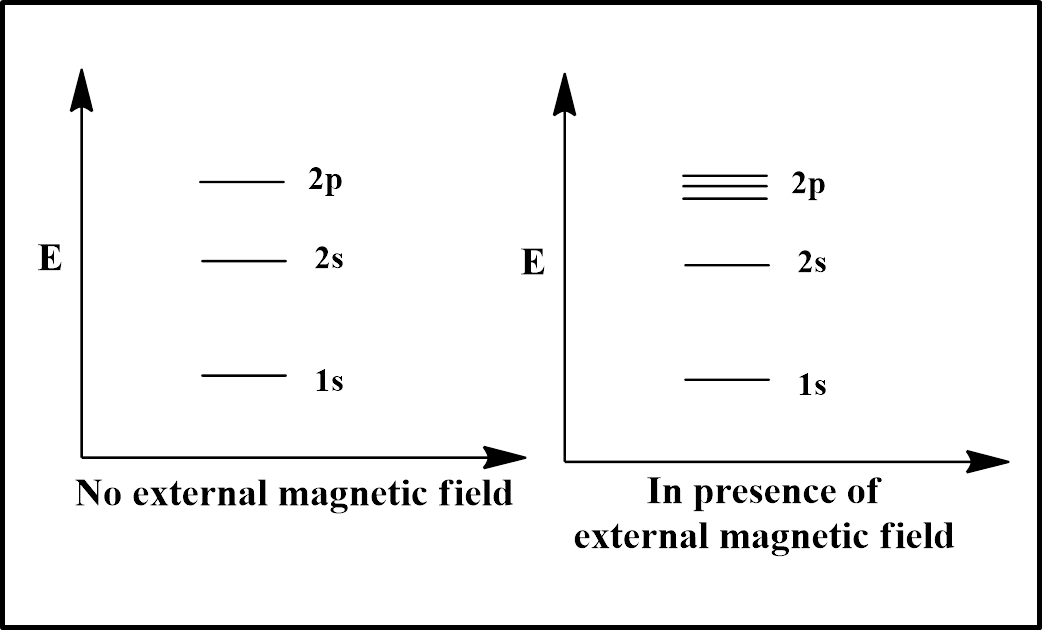
Zeeman effect explains the splitting of spectral lines in:
(A) Magnetic field
(B) Electric field
(C) Both A and B
(D) None of these
Answer
139.2k+ views
Hint: To attempt this question, compare the difference between the Zeeman effect and the Stark effect.
Complete step by step solution:
The spinning of an electron around the nucleus generates a magnetic dipole moment, denoted by the symbol “$\mu $”. As the electrons are negatively charged, the generated dipole moment points perpendicular to the area circumscribed by the spinning of the electron.
When an atom is placed in the presence of an external field which points along the z-axis, then the applied magnetic field creates a torque on the magnetic dipole moment created by the spinning of the electrons and will orient the torque along the z-axis.
${{\mu }_{z}}={{\mu }_{B}}\cdot {{m}_{l}}$, where${{\mu }_{B}}=$Bohr’s magneton and ${{m}_{l}}=$magnetic quantum number ($l$)
The orbitals of an atom have the skill to split in the presence of an external magnetic field and the number of the splits depends upon the orbital quantum number $l$.
Therefore, the number of splits $=(2l+1)$.

As the spectral splitting depends on magnetic quantum number ‘$l$” and s orbital have $l=0$, so there would be no splitting for s orbital (1s and 2s) as illustrated in the diagram. However, the $l$ value of p orbital is 1, so the 2p orbital will split into 3 splits ($=(2l+1)=(2\times 1+1)=(2+1)=3$).
Hence, the splitting of p orbitals and higher orbitals in an atom in the presence of the external magnetic field is known as the Zeeman effect. This effect is named after Pieter Zeeman (Dutch physicist).
Therefore, the Zeeman effect describes the splitting of spectral lines in presence of the magnetic field.
So, the correct answer is option (A).
Note: Analogous to Zeeman effect is the Stark effect, in which spectral lines splitting occurs in the presence of an external electric field. So, answer (B) would have been right in the case of the electric field.
Complete step by step solution:
The spinning of an electron around the nucleus generates a magnetic dipole moment, denoted by the symbol “$\mu $”. As the electrons are negatively charged, the generated dipole moment points perpendicular to the area circumscribed by the spinning of the electron.
When an atom is placed in the presence of an external field which points along the z-axis, then the applied magnetic field creates a torque on the magnetic dipole moment created by the spinning of the electrons and will orient the torque along the z-axis.
${{\mu }_{z}}={{\mu }_{B}}\cdot {{m}_{l}}$, where${{\mu }_{B}}=$Bohr’s magneton and ${{m}_{l}}=$magnetic quantum number ($l$)
The orbitals of an atom have the skill to split in the presence of an external magnetic field and the number of the splits depends upon the orbital quantum number $l$.
Therefore, the number of splits $=(2l+1)$.

As the spectral splitting depends on magnetic quantum number ‘$l$” and s orbital have $l=0$, so there would be no splitting for s orbital (1s and 2s) as illustrated in the diagram. However, the $l$ value of p orbital is 1, so the 2p orbital will split into 3 splits ($=(2l+1)=(2\times 1+1)=(2+1)=3$).
Hence, the splitting of p orbitals and higher orbitals in an atom in the presence of the external magnetic field is known as the Zeeman effect. This effect is named after Pieter Zeeman (Dutch physicist).
Therefore, the Zeeman effect describes the splitting of spectral lines in presence of the magnetic field.
So, the correct answer is option (A).
Note: Analogous to Zeeman effect is the Stark effect, in which spectral lines splitting occurs in the presence of an external electric field. So, answer (B) would have been right in the case of the electric field.
Recently Updated Pages
How to find Oxidation Number - Important Concepts for JEE

How Electromagnetic Waves are Formed - Important Concepts for JEE

Electrical Resistance - Important Concepts and Tips for JEE

Average Atomic Mass - Important Concepts and Tips for JEE

Chemical Equation - Important Concepts and Tips for JEE

Concept of CP and CV of Gas - Important Concepts and Tips for JEE

Trending doubts
JEE Main 2025 Session 2: Application Form (Out), Exam Dates (Released), Eligibility, & More

JEE Main 2025: Derivation of Equation of Trajectory in Physics

Learn About Angle Of Deviation In Prism: JEE Main Physics 2025

Number of sigma and pi bonds in C2 molecule isare A class 11 chemistry JEE_Main

Electric Field Due to Uniformly Charged Ring for JEE Main 2025 - Formula and Derivation

JEE Main 2025: Conversion of Galvanometer Into Ammeter And Voltmeter in Physics

Other Pages
NCERT Solutions for Class 11 Chemistry Chapter 9 Hydrocarbons

NCERT Solutions for Class 11 Chemistry Chapter 7 Redox Reaction

JEE Advanced Marks vs Ranks 2025: Understanding Category-wise Qualifying Marks and Previous Year Cut-offs

NCERT Solutions for Class 11 Chemistry Chapter 5 Thermodynamics

Hydrocarbons Class 11 Notes: CBSE Chemistry Chapter 9

NCERT Solutions for Class 11 Chemistry In Hindi Chapter 1 Some Basic Concepts of Chemistry




